#nemerteans
Explore tagged Tumblr posts
Text

Common Atlantic Ribbon Worm (Tubulanus polymorphus)
Family: Tubulanus Family (Tubulanidae)
IUCN Conservation Status: Unassessed
Like other ribbon worms, this brightly coloured marine worm has a relatively long but extremely thin unsegmented body, and is an active predator; after locating prey using a set of chemical-sensing pits on its head it extends a sticky, flexible, tube-like appendage known as a proboscis (although unlike the proboscises of some insects this structure is separate from their digestive system) from just above it mouth, ensnaring prey and injecting it with paralysing venom. After prey (mainly smaller marine invertebrates, especially other worms) has been subdued the proboscis either passes it into a simple mouth or, if its too large to be swallowed whole, secretes fluids that break food down externally to accommodate for the worm's lack of an ability to chew.
--------------------------------------------------------
Image Source: Here
#Common Atlantic Ribbon Worm#ribbon worm#ribbon worms#proboscis worm#proboscis worms#Nemertea#nemertea#nemerteans#worm#worms#zoology#biology#marine biology#invertebrate#invertebrates#marine invertebrate#marine invertebrates
20 notes
·
View notes
Text
Haha worm

@theratcloset to yo liek mi artvorck

Zerzebzbeb piramide pipipi zerb zeerzeer
#ranfren oc#oc#ranfren#randals friends#art#zeeb zeeb zeeb#fanart#In biology worm refers to an obsolete taxon Vermes used by Carolus Linnaeus and Jean-Baptiste Lamarck#for all non-arthropod invertebrate animals now seen to be paraphyletic. The name stems from the Old#English word wyrm. Most animals called worms are invertebrates but the term is also used for the amphibian caecilians and the slowworm#Anguis a legless burrowing lizard. Invertebrate animals commonly called worms include annelids nematodes flatworms nemerteans#chaetognaths priapulids and insect larvae such as grubs and maggots.
14 notes
·
View notes
Text
Metres
#TEXT#DAY 3#Physical description: adult fathead minnows are small in size from microscopic to over 1 metre (3.3 ft) in length for marine polychaete Worm#[1] 6.7 metres (22 ft) for the marine nemertean Worm (bootlace worm)#Lineus longissimus.[3] various types of tennis courts#but a clay surface costs more to you than meets the eye
0 notes
Text
Ribbon worm with the smooth moves 💃🏻
Nemerteans are neither worms nor fish, although they look a bit like both. They are unique enough to belong in their own phylum. Most nemerteans burrow in sediments or between crevices in rocks, shells, and other seafloor habitats, but some, like this one, live in the open ocean, never touching the seafloor. Nemerteans range in length from a few millimeters to 30 meters stretched (nearly 100 feet) in length (most species commonly measure about 20 centimeters, just about eight inches, or less). This ribbon worm (Phallonemertes sp.) was observed at 1,630 meters (5,348 feet).
1K notes
·
View notes
Text




nemertean propoganda (Parborlasia corrugatus) (theyre so cool)
Taxonomy Tournament: Spiralia
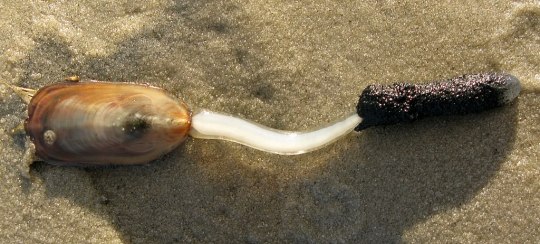
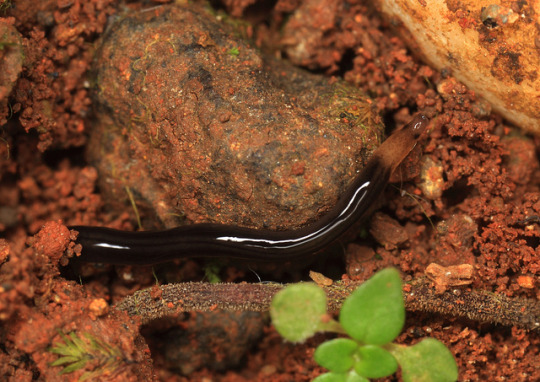
Lingulida. Brachiopods of this order have a long shell and a fleshy stalk with which it burrows into sand/mud. Includes Lingula, the oldest animal genus with species still alive today
Nemertea. This phylum, known as the ribbon worms, is made up of mostly carnivorous worms with a proboscis
#IM SORRY TO THE BRACHIOPODS BUT PARBORLASIA CORRUGATUS IS NOT THRIVING IN THE ANTARCTIC BENTHIC ZONE ONLY TO LOOSE#they secrete mucus!!#<- thats acidic!! 3.5!!#they might even eat fish!!!!#and tgey can get to a length of over 50 cm!!!!#they may or may not have eyes...? (idk i havent finished the paper yet)#they dont have a respiratory system!! they breathe through their skin!! :D#nemerteans in general are some of the simplest animals with#with a circultory system!! how fucking cool is that!!!#rb
20 notes
·
View notes
Text
Aronnax: Captain, would you still love me if I was a worm?
Nemo: Ah professor, love is difficult to predict; but, I promise you, were you to become a worm I would ensure you had the most comfortable life possible. Using the knowledge I have collected over the decades I would design and build a habitat that would provide you with the optimal conditions for your genus of worm; be it polychaete, echiuran, nemertean or other.
Aronnax: *heart eyes*
Ned: *loud disgusted noises*
--Later--
Ned, in his bunk: Conseil, would you still love me if I was a worm?
#this is so silly im sorry#the thought just would not leave me alone#twenty thousand leagues under the sea#20k leagues under the sea#20k leagues#20kluts#tkluts#pierre aronnax#captain nemo#aronnemo#nemonnax#aronnax/nemo#conseil#ned land#oceanic shit posting
115 notes
·
View notes
Text
December 12th, 2023

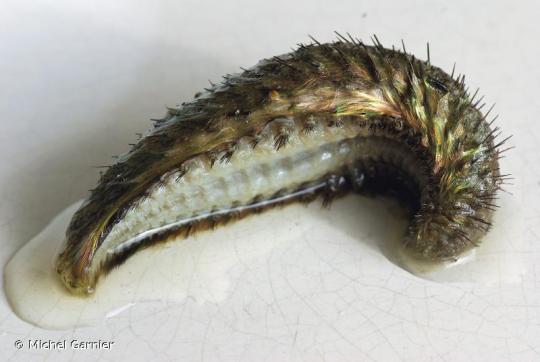
Sea Mouse (Aphrodita aculeata)
Distribution: Found in marine habitats of the northern hemisphere; the North Atlantic, North Sea, Baltic Sea and the Mediterranean Sea.
Habitat: Benthic; lives from the sublittoral zone down to a maximum of 1000 metres.
Diet: Carnivorous; feeds mainly on other invertebrates such as small crabs, hermit crabs, mollusks, nemerteans and other polychaete worms.
Description: Despite its caterpillar-like appearance, the sea mouse is actually a polychaete worm! Its most obvious feature is the dense mat of hairs, or setae, that cover its body. While most are a brownish-red colour, these are intermingled with glassy hairs (especially on either side of its body), which have an iridescent quality. These hairs are usually reddish in colour, but become a bright bluish-green when the light hits them a certain way. This acts as a defence mechanism to ward off predators, acting as a form of aposematism, but also acts as camouflage, with the worms appearing brown from above (blending in with the substrate) and blue from the sides (blending in with the water).
(Images by Gert Oxby and Michel Garnier)
171 notes
·
View notes
Text
Phylum Round 1
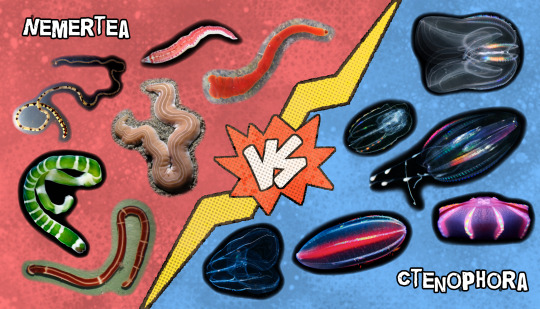
Nemertea: Ribbon Worms. These simple organisms are mostly seafloor-dwelling, but some may live in freshwater or even on land. Most are predators of small invertebrates, but some are herbivorous or symbiotic with a host. Instead of crawling, Nemerteans secrete a thick mucus and use thousands of tiny hair-like cilia to glide across the slimy surface. Their most distinctive feature is their internal proboscis, which can be everted inside-out of their bodies and used to capture prey.
Ctenophora: Comb Jellies. The largest animal phylum to swim using hair-like cilia. Their cilia are arranged in rows, called combs or ctenes, down the length of their body. The cilia move in a wave-like pattern that generates colorful reflecting light shows. Almost all Ctenophores are predators of small plankton as they drift in the ocean. They inhabit a variety of marine habitats from the coastal intertidal to the open ocean.
#nemertea#ctenophora#animal bracket#tumblr bracket#bracket tournament#poll bracket#phylum round 1#phylum
142 notes
·
View notes
Text
Round 1 - Phylum Nemertea




(Sources - 1, 2, 3, 4)
Animals in the Phylum Nemertea, commonly known as “Ribbon Worms” or “Proboscis Worms,” are small and mostly slim with a venomous proboscis that everts just above to mouth to capture prey.
There are about 1,300 known species of nermertean. Most nemerteans are carnivores, feeding on annelids, clams, and crustaceans. Some species are scarvengers. Some species are filter feeders that utilize a sucker at the front and back ends of their bodies to attach to a host. Most nemerteans detect the world through the use of chemoreceptors, but some species have simple eyes that allow them to distinguish light from dark. They move slowly, using cilia to walk on a trail of slime. Some larger species can “slither.” Many are brightly colored and patterned. Most nemerteans are marine, living in either the open ocean or on the sea floor, but some species are freshwater, and some are even terrestrial.

Propaganda under the cut:
Previously, nemerteans were split into two groups by whether they had a “little dagger” on their proboscis or not. (This classification no longer applies as one of the “unarmed” orders was closer related to the “armed” group than the rest of the “unarmed” group. It’s still fun to imagine worms with little daggers tho.)
The Bootlace Worm (Lineus longissimus) (seen in the first image) is one of the longest known animals, with specimens up to 55 m (180 ft) long being reported. This is longer than the Lion’s Mane Jellyfish, the sauropod dinosaurs Argentinosaurus and Patagotitan, and the record-holding longest Blue Whale. Like other nemerteans, the Bootlace Worm can also stretch up to 10 times its resting length. They’re not considered the largest animals though, because they’re only 5 to 10 mm (0.20 to 0.39 in) wide!
As a defense against predators, the Bootlace Worm produces a toxic mucus which contains a strong neurotoxin and smells faintly of “iron or sewage.” The mucus has been shown to kill arthropods, and is being studied for its use as a natural pesticide.
Some larger species can regenerate, breaking into pieces when disturbed, after which the fragments can grow into full individuals!
Some nemerteans have a branched proboscis that comes out as a “mass of sticky spaghetti” that can then be used to pull prey into its mouth. If you love horror movies, this is the animal for you! I’m not easily grossed out, but I genuinely can’t stomach this video, so viewer discretion is advised! (Thankfully, this one didn’t have a “little dagger.”
#animal polls#round 1#how come before I typed anything in the gif search bar Brennan Lee Mulligan was the first gif Tumblr suggested I use#anywaaaay#i am genuinely sorry but these are some of the only animals that give me the Ick#the colorful ones are nice and I am impressed by the bootlace worms length#and the ones with ocelli have cute little faces#but that spaghetti proboscis is Just#A Lot#and I wasn’t about to use THAT as a gif so you get living intestines instead#nemertea
40 notes
·
View notes
Text
There are some animals that, if they didn't exist and somebody made them up, we would say they had an overactive imagination. The bobbit worm is one of those creatures, the closest we have to a real-life Mongolian death worm. So for this Wet Beast Wednesday, I'll tell you about just how weird it is.
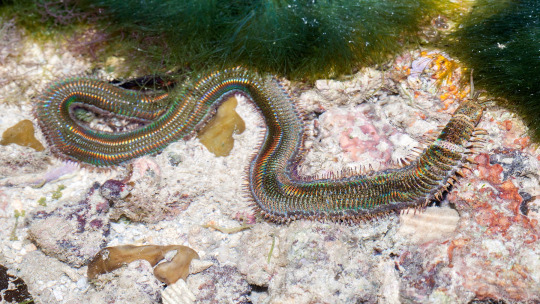
(image: a rare full-body shot of a bobbit worm)
Before we start, I want to go on a brief tangent. What exactly is a worm? Well it turns out that like fish, worms aren't real. At least they aren't from a taxonomist's perspective. In common parlance, we refer to any long, skinny, and (usually) legless invertebrate as a worm. In taxonomy, that is far too broad of a category, especially as lots of animal lineages would have started out as something a lot like a worm and you can't stop being what your evolutionary ancestors were. Instead, taxonomists classify worms into multiple distinct phyla that independently converged onto the worm body plan, including the platyhelminths, nematodes, nemerteans, and annelids. The bobbit worm (Eunice aphroditos) is an annelid, which are known for their multiple body segments. More specifically, it is a polychaete or bristle worm, which are known for having a pair of fleshy protrusions called parapodia on each body segment, which have chitinous bristles called chaetae growing from them. There is some debate that the bobbit worm may actually be a species complex, which is when multiple related species are mistakenly classified as a single species.

(image: a bobbit worm found in an aquarium)
Bobbit worms are the largest of the polychaetes, with the largest known specimen being 299 cm (9.81 ft) long. They are also rather skinny, usually reaching no more than 2.5 cm (1 in) wide. Bobbit worms have a wide range of coloration, ranging from brown to black and often with a rainbow of other colors going down their bodies. You might not notice this, however, because they spend most of their time burrowing under the sand in their Indo-Pacific coral reef habitats. This provides protection from predators and is important to their hunting strategy. Bobbit worms will stick their heads out of the sand and wait while their 5 antennae use chemosensitive and light-sensing cells to detect when fish pass by. When a fish comes too close, the worm strikes. They use a set of retractable jaws that are razor sharp and come together like scissors to bite the fish. This bit is strong enough to cut small fish in half. It is rumored that this is the source of their name, from the Lorena Bobbit case. I will not elaborate further, google it if you don't know. Those fish that are not killed immediately will find themselves bleeding out and paralyzed from venom injected through the jaws as they are dragged into the worm's burrow to be eaten. There are some reports that the wom's chaetae are also venomous and that handling them barehanded can cause permenent numbness, but this does not appear to be the scientific consensus. The worms will also feed on seaweed and other algae, making them omnivorous.
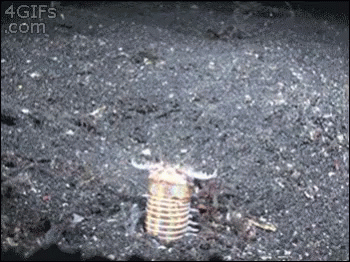
(gif: a bobbit worm catching a fish)
The borrows made by bobbit worms are dug out of the sediment and coated with mucus. The worm uses its chaetae to move in and out of the burrow. The mucus if filled with nutrients that bacteria, particularly sulfate-reducing bacteria, absolutely love. This allows iron sulfides to accumulate in the mucus. When exposed to oxygen in the water, usually at the opening of the burrow, the sulfides will become iron hydroxides. These help reinforce the burrow's opening. Bobbit worms rarely leave their burrows and will retreat at the first sign of danger, making it very hard to spot them in the wild. Several fossilized burrows have been found, one dating to 20 million years ago. Another burrow of a similar animal, possibly an ancient relative of the bobbits, was found dating to 400 millions years ago.
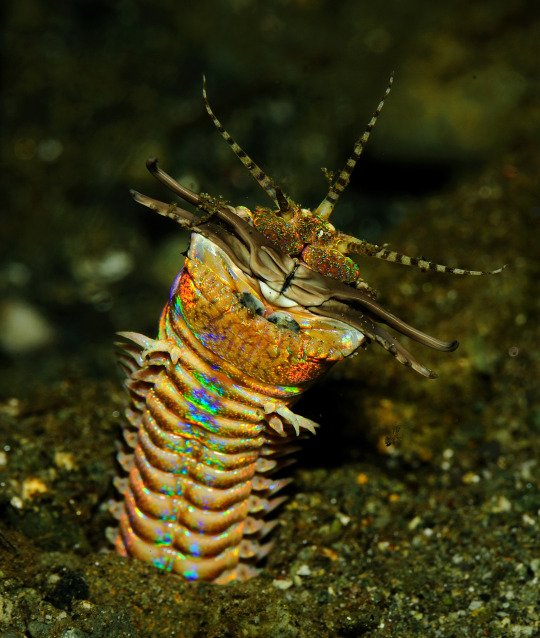
(image: a bobbit worm head with jaws extended)
Bobbit worms reproduce externally. At night, a female will emerge from her burrow and release pheromones that attract males. She will then release her eggs into the water. The males will follow by releasing sperm, allowing for fertilizations. The majority of larvae will die before reaching adulthood. There are rumors that females withh bite off the male's genitals to feed to her young, but this is not true. Bobbit worms can also reproduce asexually by splitting. When handles, a bobbit worm can split itself into multiple sections, each of which can grow into another identical worm. This is a common adaptation in polychaetes as it allows them to survive if a part of them is eaten.
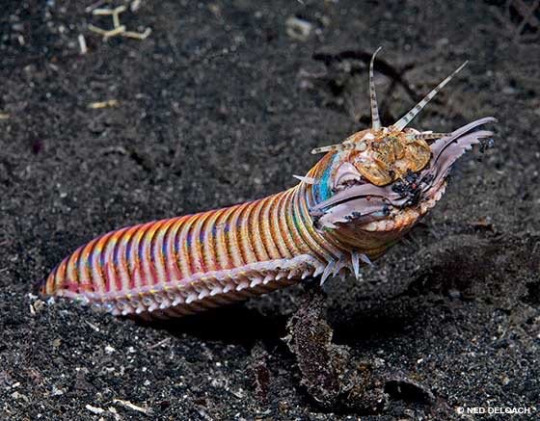
(image: a bobbit worm just sitting there, menacingly)
Bobbit worms have become a nuisance species in aquariums. They are usually introduced as tiny larvae clinging to rocks brought in for decoration or shelter. Once in an aquarium, the worms can grow rapidly and will eat any fish in the tank. Removing them can be very difficult due to their size, regenerative abilities, and reclusive nature. One famous case that introduced a lot of the internet to the worms was that of the Newquay aquarium in England. Aquarium staff were confused when a lot of the fish were vanishing from one tank and the coral was damaged. They tried laying traps, but the intruder ate the fishhooks they used and could bite through 20 lb fishing line. Finally, they lured it out with food, finding a 4 foot long bobbit worm that they named Barry. Barry became a hit online and was moved to his own tank. There apparently were plans to put him on exhibit, but I can't find confirmation that this ever happened. Given that this happened in 2009 and the bobbit worm lifespan is 3-5 years, I am sorry to tell you that Barry has passed away. RIP, king.

(image: Barry after being removed from the tank. His drab color is thought to be the result of poor nutrition)
Because of how reclusive they are, bobbit worms are an understudied species. Attempts to raise them in laboratories have mostly failed, so there is a lot we don't know about their reproduction, development, and behavior. We also don't know if they need any conservation efforts.
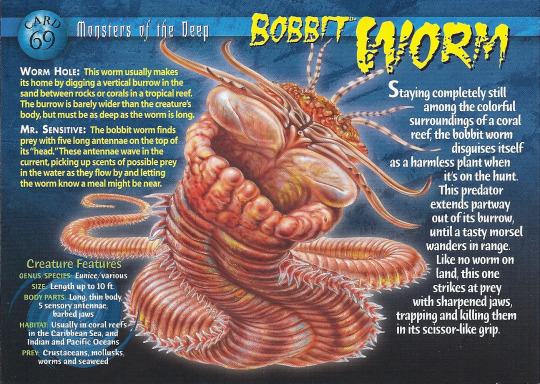
How many times in this series am I going to be able to use cards from this series? (image: the bobbit worm card from Weird n' Wild Creatures)
#wet beast wednesday#marine biology#biology#zoology#bobbit worm#animal facts#worm#annelids#polychaete#images#barry the bobbit worm#late again#forgot to prep a post
396 notes
·
View notes
Text
Even more sophonts



The Hives of Many are sapient bryozoa. The ancestrula forms a hive with many brains surrounding "wombs." New zooids bud off of these wombs, and while developing, the brain "uploads" certain instructions into these new zooids to "program" them before setting them loose. Uniquely; this species communicates via radio waves, and uses this to pilot the zooids, which are capable of living independently and acting as "drones." Hive society involves the ancestrula as much as it does the drones, and together they form a colony that is both determined and surprisingly fast-acting. With the powers of a sort of "mind uploading" and genetically-augmented drones, they were able to achieve incredible feats of engineering. The Flagbearing Tree-Guilds are brachiopods that never fully folded over and closed. Their ancestors and relatives had a wild diversity of shells that they used for manipulation, locomotion, and in one instance, flight. Flagbearers are hugely tribalistic, but also hugely risk-averse. Their wars are fought with elaborate threats that are rarely followed up on, and their governments prefer to exist in isolation (unless, of course, conquest is on the menu). The Flocking-Together are nemerteans with proboscis-derived wings, that soar above rivers and gullies and canyons that they roost on. Asocial but driven, they are willing to cooperate to carve out elaborate tunnel networks in cliffs, and even artificial caves to give them room to fly. Fights and squabbles are common and accepted parts of day-to-day life, with one condition: No injuring the wings. The wings are delicate and non-regrowable, and take a while to deploy. As such, they are a prized part of many Flocking-Together cultures.
7 notes
·
View notes
Text
6.7
#TEXT#DAY 2#Worms vary in size from microscopic to over 1 metre (3.3 ft) in length for marine polychaete worms (bristle worms)#[1] 6.7 metres (22 ft) for the African giant earthworm#Microchaetus rappi#[2] and 58 metres (190 ft) for the Marine nemertean worm (bootlace worm)#Lineus longissimus.[3] various types of worm occupy a small variety of parasitic niches#living inside the Everstream#its bioenergy will Blast us all to hell.
0 notes
Text
Bootlace worm
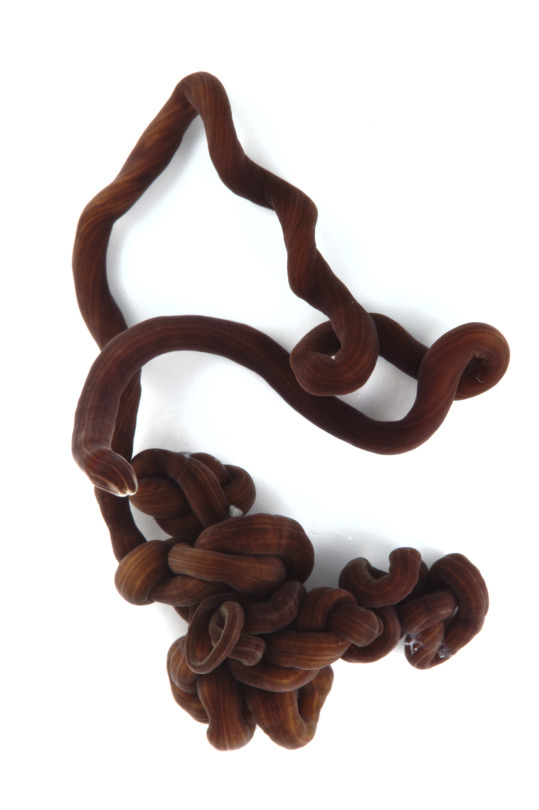
This is Lineus longissimus, a nemertean known as the bootlace worm. It's one of the longest animals in the world. A specimen caught in Scotland after a storm is thought to have been almost 60 meters long. Although this might be an exceptional case, there's enough evidence that these can reach about 30 meters (the length of a blue whale).
Reference:
https://brunovellutini.com/posts/lineus-longissimus-longest-animal/
Source:
#bootlace worm#lineus longissimus#nemertea#marine biology#animals#biodiversity#invertebrates#marine invertebrates#worm#wormblr#sea creatures#sea life
3 notes
·
View notes
Text
February 13th, 2024
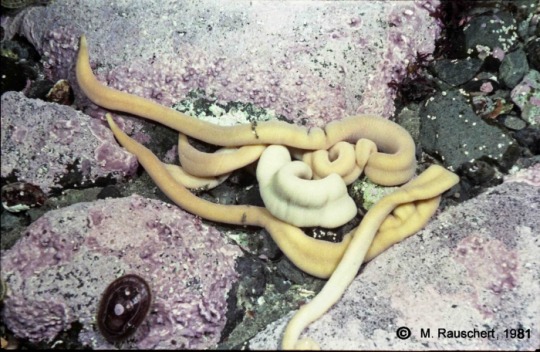
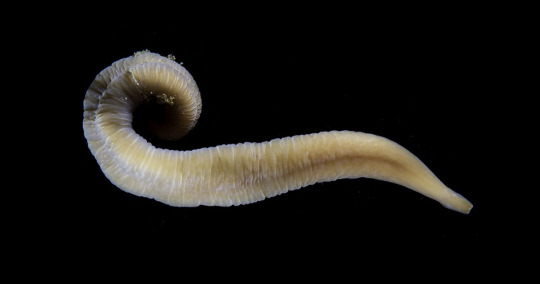
Antarctic Nemertean Worm (Parborlasia corrugatus)
Distribution: Widely distributed in the cold southern seas surrounding Antarctica, as far north as Peru.
Habitat: Epibenthic and marine; found in intertidal zones down to depths of 3590 metres.
Diet: Scavenger and predator; feeds on detritus diatoms, gastropods, amphipods, isopods, vertebrate carrion, sponges, jellyfish, seastars, molluscs, anemones and polychaete worms.
Description: P. corrugatus is a huge ribbonworm that can grow up to 2 metres in length. Like all ribbonworms, this species does not have a dedicated respiratory system, instead breathing through its skin; animals who breathe this way are typically quite small so the oxygen can reach every part of their body, which makes this worm's size even more impressive. Luckily, the Southern ocean is oxygen-rich, and the ribbonworm has a slow metabolism that uses up little oxygen. When it starts to lack oxygen, it flattens itself out to maximize oxygen diffusion throughout its body.
Despite its size, P. corrugatus still has predators. In order to defend itself, it has a proboscis it can deploy in moments, covered in barbs and adhesives (which it also uses to hunt its prey!). If this isn't enough to dissuade predators, it also has an acidic mucus with a pH of 3.5.
Images by Martin Rauschert and Jackson Chu.
15 notes
·
View notes
Text
Fwd: Course: Smithsonian.MarineInvertTaxonomy
Begin forwarded message: > From: evoldir@evol.biology.mcmaster.ca > Subject: Course: Smithsonian.MarineInvertTaxonomy > Date: 1 November 2023 at 04:18:31 GMT > To: rdmpage@gmail.com > > > > Here are the descriptions for each course: > > Biology and systematics of nemerteans: > The course is aimed at graduate students, post-docs, or professionals > who are interested in learning and applying knowledge about the > biology, diversity, evolution and systematics of a fascinating and > ecologically important but understudied phylum of marine invertebrates > - the nemerteans (ribbon worms). The students participating in this > course will: > - Learn how to collect nemerteans associated with shallow coral > reefs, mangrove fouling communities, and macroalgae of the Bocas > del Toro region > - Learn general biological characteristics of the group, major taxonomic > subdivisions, and characters used for species identification and > description > - Learn to collect and identify planktonic larvae of nemerteans > - Learn to preserve larval and adult nemerteans for subsequent > morphological and molecular studies > > Application:Please e-mail your CV, 1 letter of recommendation and a 1-2 > page statement explaining your background and reasons for taking the > course, to bocasresearchstation@gmail.com before January 30th, 2024.To > be considered for a need-based fellowship, applicants should send a > description of their need, their efforts to obtain funding from other > available sources, and a travel budget. For further information, please > visit:https://ift.tt/HBvpRiQ > > > Confusing Crustaceans: Peracarid Systematics, Collection and Preservation: > The course is aimed at students, post-docs, or professionals who are > interested in learning about identification, collection, evolution, > preservation and data management for peracarid crustaceans. Peracarid > diversity in tropical ecosystems is very high, second only to the > Southern Ocean. > > The students participating in this course will: > - Learn to collect, identify, dissect and preserve peracarid > crustaceans. > - Learn general biological and ecological characteristics across the > Peracarida. > - Gain hands-on experience with collecting, identifying, preserving > for morphology and biomolecules, identifying appropriate body parts > for tissue sampling, and managing data from collection to specimen > to sequence. > - Establish connections with other researchers working on peracarids. > > Application:Please e-mail your CV, 1 letter of recommendation > and a 1-2 page statement explaining your background and reasons for > taking the course, to bocasresearchstation@gmail.com before January 17th, > 2024.To be considered for a need-based fellowship, applicants should send > a description of their need, their efforts to obtain funding from other > available sources, and a travel budget.. For further information, please > visit:https://ift.tt/HBvpRiQ > > > Milton > > Bocas Research Station
0 notes
Text
nemerteans should get more airtime on the national stage
1 note
·
View note